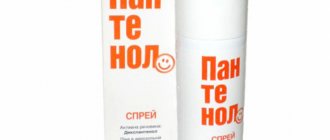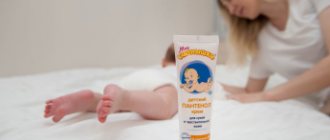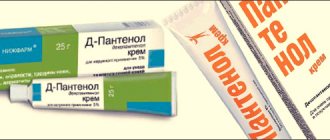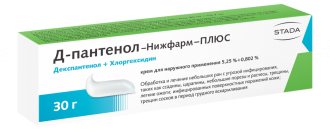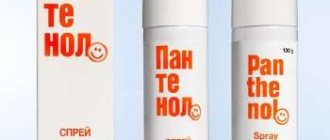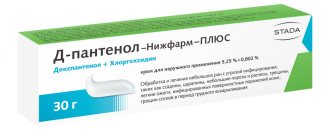"D-Panthenol" from Hungarian is a drug that has earned the trust of consumers. At the beginning of 2022, “D-Panthenol” (ointment and cream) appeared on the shelves of pharmacies under a new trade name - “D-Panthenol Novatenol”
in new packaging.
The manufacturer made the packaging even brighter and more attractive, but tried to preserve the individuality and recognition of the brand for consumers. At the same time, the quality of the product remains at the same high level - the buyer receives a European quality product with an expert approach to healing damaged skin. This is an excellent opportunity to once again remind you why pharmacists and consumers should pay attention to this drug.
“D-Panthenol Novatenol” is one of the popular drugs for the treatment of diseases accompanied by a violation of the integrity of the skin
(according to IQVIA data on Sell In sales in rubles as of January 2020)
. Dexpanthenol contained in the drug stimulates skin regeneration, normalizes cellular metabolism, accelerates mitosis and increases the strength of collagen fibers.
Composition and release form
An external medicine that improves tissue trophism and accelerates their regeneration is Dexpanthenol. The instructions for use indicate that ointment, cream or gel 5%, aerosol or spray are in demand in dermatology and surgery. Reviews from dermatologists report that this medication helps in the treatment of burns, bedsores, diaper rash or diaper dermatitis in adults, children (including infants and newborns). The main active ingredient of the drug is dexpanthenol. Dosage forms:
- ointment for external use 5%: a homogeneous mass of light yellow color, with a characteristic odor of lanolin (25 g or 30 g in an aluminum tube, 1 tube in a cardboard pack; 25 g in a jar, 1 jar in a cardboard pack);
- aerosol for external use 5% (58 g each in an aluminum aerosol can with a continuous valve, 1 can in a cardboard box).
1 g of ointment contains:
active ingredient: dexpanthenol - 0.05 g.
auxiliary components:
- cholesterol;
- petrolatum;
- methyl parahydroxybenzoate (nipagin);
- Vaseline oil;
- white petroleum jelly;
- isopropyl myristate;
- propyl parahydroxybenzoate (nipazole);
- purified water.
The active ingredient of the aerosol is dexpanthenol, its content in 1 container is 2.5 g.
Cream for newborns Dexpanthenol
The drug for external use Dexpanthenol contains a derivative of pantothenic acid - a B vitamin, which on the surface and in the thickness of the skin is converted into pantothenic acid and stimulates the division of epithelial cells, the process of tissue regeneration and cellular metabolism. Dexpanthenol cream, penetrating into tissues, stimulates lipid and carbohydrate metabolism, the formation of porphyrins and corticosteroids. In medical practice, this ointment is used to treat damage and dryness of the skin of various etiologies. In what cases is it used in children:
- Diaper dermatitis.
- Minor abrasions and mild irritation after ultraviolet exposure and x-ray exposure.
- Preventing or treating diaper rash.
- It is worth knowing that it is forbidden to lubricate wet surfaces with ointment.
When used in patients with trophic ulcers on the lower extremities or long-healing skin grafts, the treatment course must be carried out under the supervision of a doctor. According to the instructions, it is allowed to use the ointment for the treatment and regeneration of a baby’s skin with diaper dermatitis, the treatment of diaper rash, minor scratches, abrasions, and burns after exposure to ultraviolet radiation in newborns. The occurrence of adverse reactions and symptoms of overdose is extremely rare. Minor allergic reactions to the active substance of the drug are possible.
Mechanism of action of Dexpanthenol
Dexpanthenol is an analogue of pantothenic acid, a stimulator of the synthesis of coenzyme A, which is involved in almost all metabolic processes, including the metabolism of fats and carbohydrates. Dexpanthenol stimulates the acetylation of choline and its subsequent conversion to acetylcholine, and also stimulates the synthesis of corticosteroid hormones. Due to its good ability to penetrate tissue in high local concentrations, dexpanthenol is used as the main active pharmacological ingredient in many dosage forms for external use (for example, ointments and lotions, sprays).
Promotes intensification of the formation of epithelial tissue.
The substance is used to treat dermatological conditions to relieve itching or promote the healing of entire epithelial disorders resulting from traumatic injuries, exposure to high temperatures or UV radiation. Dermatological effects of topical dexpanthenol include increased fibroblast proliferation and accelerated re-epithelialization during wound healing. In addition, it exhibits protective and moisturizing properties, and drugs based on this component can also be used to prevent damage to various parts of the body.
Dexpanthenol ointment: indications for use
The drug is used in medicine to treat various skin lesions, dermatological diseases and inflammations. Dexpanthenol gel is prescribed for the following diagnoses and conditions:
- thermal, chemical and sunburns;
- skin restoration after transplantation;
- increased dryness due to vitamin deficiency, dehydration;
- trophic ulcers on the legs;
- poorly healing wounds;
- anal fissures;
- bedsores;
- frostbite of the face.
Dexpanthenol can be used to treat wounds after surgery and remove sutures. The ointment helps relieve skin inflammation when a colostomy is installed, after a tracheotomy. It is recommended during lactation to eliminate painful cracks in the nipples. In pediatrics, Dexpanthenol is used for the following indications:
- atopic and diaper dermatitis;
- skin treatment for hypersensitivity in a premature baby;
- redness and burning after exposure to the sun or cold air.
Dexpanthenol ointment for hemorrhoids helps relieve discomfort, moisturizes and softens the skin around the anus. It is prescribed after surgery to remove hemorrhoids, for paraproctitis, for accelerated healing and restoration of wounds. For burns and irritation, Dexpanthenol ointment can be used to restore facial skin after chemical peeling, cleansing or other cosmetic procedures. It can be applied to the eyelids after plastic surgery to speed up regeneration, increase elasticity and reduce swelling.
What is the ointment for?
The drug is intended for application to the surface of skin that has been subjected to thermal or radiation burns. The following pathologies are indications for its use:
- eczema, ulcers, including trophic ones;
- cuts, cracks, wounds, scratches;
- dry skin, causing injury;
- complex treatment of bedsores;
- furunculosis.
Dexpanthenol in the form of gel and cream is used in the postoperative period to accelerate the healing of sutures. Dexpanthenol is often used to eliminate allergy symptoms in contact dermatitis or neurodermatosis. Before applying the drug, aseptic treatment of the damage is required. The wound or cut is washed to remove mechanical impurities. Then they are treated with solutions with a disinfectant effect (Chlorhexidine, Miramistin) and dried. If Dexpanthenol is intended for the treatment of children, then a 1-2 cm strip of the product is sufficient. For therapy in adults, this amount increases by 2-3 times. The drug is applied and evenly distributed on the skin 2-4 times a day. During treatment with Dexpanthenol E cream with tocopherol acetate, the same dosage regimen is followed.
Editorial conclusion
D-panthenol does its job well in treating children and adults. The drug in the form of an ointment can be called stronger, which means it can be used rationally for serious skin damage, burns, abrasions. The cream is an excellent preventative when there is a risk of chapping, frostbite, and sunburn.
The range of applications of D-panthenol is quite wide. It is used in pediatric practice and for the treatment of adults. The cream can be taken with you in windy and hot weather, and the ointment can be kept in the first aid kit for first aid and treatment in case of significant skin injury.
We concluded that D-panthenol cream is an excellent prophylactic agent, and the ointment can be used effectively for treatment. Do not forget that self-medication can be dangerous and you should always consult a doctor before starting to use the drug.
What is Vertex Dexpanthenol ointment used for?
Dexpanthenol is a derivative of pantothenic acid. Pantothenic acid, a water-soluble B vitamin, is a component of coenzyme A. It stimulates skin regeneration, normalizes cellular metabolism, and increases the strength of collagen fibers. An increased need for pantothenic acid is observed when the skin or tissues are damaged, and its deficiency can be compensated for by the local use of dexpanthenol. Optimal molecular weight, hydrophilicity and low polarity make it possible to penetrate into all layers of the skin. Has a regenerating, weak anti-inflammatory effect. Indications for the drug Dexpanthenol-VERTEX:
- Violations of the integrity of the skin caused by mechanical, chemical, temperature factors or after surgical interventions (burns of various origins (including sunburn);
- scratches, abrasions, wounds;
- bedsores; poorly healing skin grafts;
- aseptic postoperative wounds);
- inflammatory processes on the skin;
- dermatitis;
- boils;
- trophic ulcers of the lower extremities;
- skin care around tracheostomy, gastrostomy and colostomy;
- treatment and prevention of the consequences of adverse effects on the skin of environmental factors (cold, wind, dampness);
- in children - diaper dermatitis, scratches and minor irritation after exposure to the sun, ultraviolet and x-rays;
- treatment and prevention of diaper rash;
- cracks and inflammation of the nipples of the breast in nursing mothers;
- for the treatment and protection of dry skin as a source of neutral fats and dexpanthenol
D Panthenol
The main component of the current format is dexpanthenol . Upon penetration into the skin, it is converted into pantothenic acid during metabolism. The component forms a complete metabolic process in cells and tissues. Thanks to it, the deficiency of pantothenic acid is replenished, which makes it possible to activate various functions of restoring the condition of the dermis.
The strength of collagen fibers is also restored, which helps to improve the general condition of the integument - elasticity is formed. In addition to the main function of restoration, the medicine moisturizes, nourishes, softens, and also creates a protective layer.
Application area:
- Various dermatitis, burns, cracked nipples.
- Anal fissures.
- Prevention of skin diseases.
- In case of damage to the mucous membrane of the cervix.
- For dryness and injuries of the epidermis.
- For cosmetic purposes for frostbite or chapping.
- In the treatment and prevention of diaper rash.
What is ointment used for in children?
Dexpanthenol is one of the medications used for various skin lesions. This medicine is in demand among young mothers because it helps with cracked nipples. Is it possible to use it in infants and how does this drug act on children's skin? Dexpanthenol has the ability to stimulate regenerative processes in tissues. After application to the skin, the active substance of the drug is converted into pantothenic acid, which is actively involved in many metabolic processes. It stimulates the regeneration of skin cells and normalizes their metabolism, and also increases the strength of collagen fibers.
The use of Dexpanthenol for children is possible from birth. This drug is harmless for both newborn babies and infants up to one year old.
The drug should not be used in children with hypersensitivity to any of the components of the ointment. In addition, treatment with Dexpanthenol is prohibited for weeping wounds. The medication is used only for external treatment. The ointment should be applied to damaged areas once a day or more often if indicated for this. For an infant, the medicine is applied to the skin after bathing or changing a diaper. Nursing mothers are advised to lubricate their nipples after feeding, and the drug should be washed off before the next feeding. Most reviews from parents who used Dexpanthenol for various skin problems in children note a good healing effect of the drug. Mothers are satisfied with the ease of use of the medication and safety for children of any age. The ointment is also praised for its low price.
Key differences and similarities
To understand the difference between D-panthenol ointment and cream, you need to know the basic differences between these two dosage forms. The main difference is the basis.
| Ointment | Cream |
| Does not contain water | Contains water |
| Creates a greenhouse effect after application | Pleasantly cools |
| Has a systemic effect, penetrating the bloodstream | Remains on the upper layers of the skin, has a local effect |
| Leaves greasy marks and needs to be removed from the skin | Absorbs and leaves no greasy residue |
| Represents only medical drugs | Can be both a medical drug and a cosmetic product |
The base for the ointment always includes fats, there is no water in it. Due to this, after application to the damaged area, a greenhouse effect is created, which leads to active and deep absorption of medicinal components. Therefore, the ointment has a systemic effect and usually has more contraindications if it contains toxic components.
The base for the cream is not so greasy. It contains water. The light emulsion practically does not penetrate the bloodstream and has a local, superficial effect. In addition, due to the soda content, a pleasant cooling effect is created.
The base also affects ease of use. The cream can be applied at any time, it is not noticeable on the skin and does not require rinsing. The ointment has a greasy base, it is not completely absorbed and remains on the skin. Some time after application it needs to be washed off.
An important difference is that the ointment is an exclusively medicinal form of release. When buying it, you can be sure of the content of active ingredients. In this case, you need to carefully look at contraindications and possible adverse reactions.
Instructions for use
Orally 200 - 400 mg per day. Children - from 100 mg to 300 mg per day. Solution for external use: for rinsing the mouth should be diluted in half in an equal ratio with water, for the scalp 1 to 3, for inhalation the solution should not be diluted. Dexpanthenol 5% in external form (cream or ointment) is applied topically once a day, not washed off. The gel is also used, but with a frequency of 2-3 times a day. The aerosol is used intranasally. Children from 6 years old and adults 1-2 injections into each nostril 2-3 times a day. For newborns with diaper rash, it is necessary to first wash the affected area, wipe the skin dry, and only then apply the product. Infants usually tolerate the medication well.
During pregnancy and breastfeeding. During pregnancy, dexpanthenol is approved for use in external form. During lactation, if there are cracks in the nipples, a few drops of ointment or cream should be applied after feeding the newborn. The medication must be washed off before feeding.
What is better to choose
The cream and ointment contain a similar medicinal component and are used according to the same regimen and dosage. Their prices are also not much different. For shallow skin damage, it is better to use cream. It can be applied at any time of the day. When there are serious injuries, you should use an ointment that will affect the deeper layers.
The ointment is best suited for chapping, frostbite, and cracked nipples. For minor burns and scratches, you can use a convenient cream.
Contraindications and side effects
Qualified doctors do not prescribe this drug to people who are allergic to the composition of Dexpanthenol. The drug has no other restrictions. Use of the drug during pregnancy For pregnant women, as well as mothers during lactation, doctors prescribe the use of Dexpanthenol without any restrictions. This remedy helps heal cracks in the nipples, as well as relieve inflammation. It is important to remember to cleanse the skin of the gel immediately before feeding your baby. The use of Dexpanthenol should be stopped if a woman develops a rash and allergies. In this case, you also need to consult a doctor.
There is a small risk of an allergic reaction and rash in a patient who has used a large amount of the product.
Dexpanthenol combines well with succinylcholine, increasing its effect. No other interactions were identified. Some patients prefer to use different gels, applying them to the same area of the skin. In this case, experts advise alternating their use, applying the next drug after a while. To date, no cases of overdose with Dexpanthenol have been identified. There are no complications even when taking the gel orally.
According to experts, patients using Dexpanthenol rarely experience any side effects. This drug is well accepted even by children's bodies. In some cases, an allergy appears caused by the body's increased sensitivity to the components that make up Dexpanthenol. In such a situation, you should immediately interrupt treatment and contact your doctor.
What can I replace the cream with?
If necessary, a replacement can be found for the drug. There are quite a lot of drugs that are similar in composition and action. Here are some of the drug's analogues:
- Panthenol;
- D - Panthenol;
- Bepanten;
- Bepanten plus;
- Pantoderm;
- Panthenol Pharmstandard;
- Pantoderm;
- Krneregel.
There are still many substitutes. Each of them has its own specific characteristics. Before use, be sure to read the instructions. Despite the abundance of analogues, Dexpanthenol is often compared with Panthenol. Sometimes doctors themselves recommend one of these remedies to choose from. Indeed, the composition and effect of these medications are very similar. The main component for both products is dexpanthenol. Bepanten is a more expensive product in terms of cost. In addition to medicinal components, it also includes caregivers. They soften and moisturize the skin.
Based on reviews and practice, the drug is really high quality and effective. Produced by some German pharmaceutical companies. Dexpanthenol is produced by domestic manufacturers. Much more affordable. And, according to reviews, its effect is no worse.
Panthenol and Dexpanthenol: what is the difference?
Both products contain dexpanthenol. The products have no side effects and are actively prescribed in pediatrics for the treatment of abrasions, wounds or other injuries to the skin, for the treatment of dryness and diaper rash. Used as a prophylactic agent in cosmetology. An additional function is the restoration of metabolism at the cell type level, as well as the restoration of collagen fibers. Dexpanthenol contains pantothenic acid, which penetrates deeply into all layers and begins to act almost instantly. Stimulation of regeneration and cellular metabolism occurs. Has a healing and anti-inflammatory effect.
As auxiliaries: petroleum jelly and petroleum jelly, isopropyl myristate, which ensures rapid deep penetration and absorption. It acts locally, the active components do not enter the bloodstream, but act exclusively at the level of cells that are damaged, which minimizes the possibility of intoxication. D Panthenol contains dexapanthenol (pantothenic acid). Excipients: beeswax, lanolin, propylene glycol, paraffin. Thanks to these substances, rapid absorption occurs, which makes the product very convenient to use.
Which is better: Bepanten or Dexpanthenol?
If we are guided solely by patient reviews, then the drugs Dexpanthenol and Bepanten are complete analogues with comparable effectiveness. A superficial comparison only confirms this opinion. We are talking about almost identical pharmaceutical products, the main difference between which is the manufacturer. After treating the problem area of the skin, the active agent (provitamin B5) is converted into pantothenic acid. This substance is close in composition to the components of the dermis, and therefore is best suited for its regeneration, moisturizing and treatment. Properties of dexpanthenol:
- moisturizes and saturates the dermis with nutrients;
- stimulates cellular regeneration in damaged segments;
- eliminates swelling, inflammation, redness and irritation;
- promotes rapid healing of cracks, abrasions and shallow wounds.
Both drugs are indicated for burns of the skin, diaper rash, dermatitis, bites, erosions, bedsores and trophic ulcers. There is no fundamental difference in terms of pharmacological action and effectiveness between the two drugs. But differences still exist. Cream Panthenol, D-Panthenol, Dexpanthenol and Bepanten are representatives of the clinical and pharmacological group of tissue regeneration stimulators. These are drugs that normalize tissue trophism and intracellular metabolic processes. High therapeutic effectiveness is achieved due to rapid epithelial absorption and penetration into the deep spheres of the skin.
Bepanthen and Dexpanthenol, what is the difference?
These are drugs whose main active ingredient is dexpanthenol. Provitamin B5 contained in the products is converted into pantothenic acid. Bepanten together with Dexpanthenol:
- promote healing of wounds, cracks and abrasions;
- relieve irritation, swelling and redness;
- accelerate cell regeneration; moisturize and nourish the skin.
The anti-inflammatory activity of the drugs allows them to be used for diaper rash, dermatitis, insect bites and anal fissures. Medicines are prescribed: for the treatment of trophic ulcers; erosions; bedsores. Bepanten and Dexpanthenol are prescribed for the treatment of bedsores. The main difference between the 2 drugs is the excipients they contain. The composition of Dexpanthenol ointment includes
:
- nipazole;
- petrolatum;
- cholesterol;
- Vaseline oil;
- purified water;
- isopropyl myristate;
- nipagin.
Bepanten contains beeswax. Bepanten includes:
- paraffin;
- beeswax;
- protein;
- cetyl and stearyl alcohol;
- lanolin, made from sheep fat;
- almond oil;
- water.
The first remedy is based on inexpensive chemicals and preservatives, which did not in any way affect its therapeutic properties, but did affect its price. Bepanten is a more expensive analogue. Due to its natural composition, it is not dangerous for the skin, because... does not clog pores and does not cause allergies. There is no significant difference which drug an adult should use for treatment. Therefore, Dexpanthenol is most often purchased due to its inexpensive price and effective effect.
Pantothenic acid, part of the B complex of vitamins (vitamin B5), was discovered in 1931 by RJ Williams (1893-1988) during the study of microbial growth factors. The name “pantothenic acid” was given to this substance by Williams and Saunders in 1933 [1]. In 1934, it was shown that pantothenic acid has a stimulating effect on the proliferation of yeast cells [2], which served as a prerequisite for the creation in 1944 of the first drug dexpanthenol for external use. In 1947, the biochemical function of pantothenic acid was elucidated when Lipann et al. showed that acetylation of sulfonamide requires a cofactor containing pantothenic acid [3].
Pantothenic acid itself does not have any specific effect when used in healthy animals or humans. However, it is a component of coenzyme A, which serves as a cofactor for enzymatically catalyzed reactions such as the transfer of acetyl groups, which are important for the synthesis and oxidation of fats, carbohydrate metabolism, gluconeogenesis, and the synthesis of steroid hormones and porphyrins. Coenzyme A is also involved in the process of protein modification, affecting their stability and activity. Particular importance in medicine is given to pantothenic acid as part of the biosynthesis of acetylcholine, leading to a decrease in acetylcholine levels and decreased peristalsis.
Dexpanthenol is a stable alcohol analogue of pantothenic acid. However, unlike it, it penetrates the skin well. When applied topically, dexpanthenol is easily absorbed into the skin and quickly turns into pantothenic acid, which is part of coenzyme A, which catalyzes the synthesis of fatty acids and sphingolipids that are part of the lipid composition of the stratum corneum of the epidermis. Thus, pantothenic acid is an important component necessary to maintain the physiological functions of the skin, in particular the barrier function. It has been established that dexpanthenol, when applied externally, acts as a moisturizing factor and also promotes wound healing, which is currently widely used in the pharmaceutical industry.
Dexpanthenol is highly soluble in water and alcohol, practically insoluble in fats and is the most stable form of pantothenic acid in liquids. These properties make it possible to use this substance in a concentration of 2 to 5% for external therapy of the skin and mucous membranes in the form of various dosage forms - ointments, creams, emulsions or solutions, as well as in the form of lozenges. In addition, dexpanthenol can be administered systemically to adult patients in a dose of 250 to 500 mg, which significantly expands the scope of its possible use. Thus, dexpanthenol is used for local adjuvant therapy for erosion and dystrophic lesions of the cornea and conjunctiva; for inflammatory diseases, violation of the integrity of the mucous membrane of the oral cavity, nose, larynx, respiratory tract, including in the postoperative period; for systemic therapy of intestinal paresis in the postoperative period; to accelerate epithelization in case of skin injuries, as well as in case of irritation, inflammation of the skin (for example, sunburn); for the prevention and treatment of scratches and cracks in the skin, with its xerosis; for caring for the mammary glands during lactation (prevention and treatment of cracked nipples); for the prevention and treatment of diaper rash in children and adults; in the treatment of chronic ulcers, bedsores, as well as skin transplantation; for topical treatment of erosion of the cervix and gastric mucosa.
As stated above, pantothenic acid is essential for the normal functioning of the epidermis. The most studied aspects of the topical activity of dexpanthenol, which, according to the results of numerous laboratory and clinical studies, acts as a moisturizer, maintaining the softness and elasticity of the skin. Thus, as a result of a randomized, double-blind, placebo-controlled study of the effect of dexpanthenol on the state of the epidermal barrier in vivo, it was demonstrated that the use of topical forms containing this substance for 7 days improved the hydration of the stratum corneum and reduced transepidermal water loss [4].
The ability of dexpanthenol to moisturize the skin is associated with its hygroscopic properties and ability to retain moisture [5]. The hydrating effect of dexpanthenol is associated with its ability to restore the epidermal barrier. In an experimental study conducted on porcine skin biopsies, it was found that dexpanthenol increases the molecular mobility of several lipid and protein segments of the stratum corneum, thereby helping to moisturize even severely dehydrated skin. It has been shown that dexpanthenol interacts with lipid segments of extracellular plates and protein residues in corneocytes of the stratum corneum and, thus, compensates for dehydration of the epidermis by maintaining/increasing molecular fluidity [6].
The moisturizing properties of dexpanthenol have determined its place in various cosmetic products, such as after-sun care and children's skin care products. However, this substance also has anti-inflammatory properties. It has been shown that cosmetics containing dexpanthenol are significantly superior to placebo in terms of the anti-inflammatory effect on experimental UV-induced erythema [7].
The wound-healing effect of dexpanthenol has been known since the discovery of this substance, but the mechanism of wound healing was discovered relatively recently. The beneficial effect of dexpanthenol on wound healing is the result of increased fibroblast proliferation and accelerated epithelialization [8], which is observed in the treatment of both deep and superficial injuries.
Dermal fibroblasts are known to play a key role in the healing of skin wounds. When dexpanthenol acts on human fibroblasts, their proliferation, cell migration to the site of inflammation, fixation of fibroblasts in the wound, and increased collagen synthesis are noted [9]. This occurs due to the regulatory effect of dexpanthenol on fibroblasts at the genetic level. As a result of gene expression analysis in human dermal fibroblasts cultured in the presence of pantothenate at a concentration of 20 mg/ml and in untreated cells, an increase in the production of IL-6, IL-8, Id1, HMOX-1, as well as an increase in the expression of HspB7 and CYP1B1 was found [ 10]. In a randomized, double-blind study of samples obtained by puncture biopsy from areas of previously damaged skin treated with dexpanthenol, and biopsies from placebo-treated skin, increased expression of the genes IL-6, IL-1b, CYP1B1, CXCL1, CCL18 and KAP 4−2 was found [11], which confirms the correlation between the results of in vitro and in vivo studies. It is noted that wound healing in the presence of dexpanthenol occurs due to dexpanthenol-induced regulation of mRNA gene expression.
The therapeutic effect of dexpanthenol on the skin is also facilitated by its pharmacological properties. Thus, unlike pantothenic acid, dexpanthenol penetrates well into the skin, where it is quickly converted into pantothenic acid, as demonstrated in studies conducted both in animal experiments and in vivo with the participation of healthy volunteers. It was noted that the absorption of dexpanthenol depends on the drug base. It decreased if olive oil was used as the base of the topical product. However, both the rate and extent of penetration of dexpathenol were higher when used in the form of a water-in-oil emulsion than in the form of an oil-in-water emulsion [12].
Dexpanthenol is a non-toxic substance. However, the literature reports isolated cases of local allergic reactions or skin irritation due to the use of dexpanthenol [13, 14]. It should be noted that most unwanted side effects were noted when this drug was administered orally, but not when used externally. In general, the experience of fairly widespread use of dexpanthenol in clinical practice indicates a very rare development of undesirable side effects.
Thus, more than 70 years of experience in the use of dexpanthenol in medicine has shown that this substance helps improve the barrier properties of the skin, and also has anti-inflammatory and wound-healing properties, which allows it to be widely used in dermatological practice as an independent remedy for the treatment of various skin diseases , and as part of complex therapy.
An example of the complex use of dexpanthenol in the external therapy of dermatoses is Tetraderm
, recommended for the treatment of acute and chronic inflammatory dermatoses with concomitant bacterial and mycotic infection or with a high probability of secondary infection. It contains mometasone, gentamicin, econazole and dexpanthenol. The drug is recommended to be applied to the skin of adult patients 1-2 times a day until a positive clinical result is achieved, but not more than 4 weeks.
Own experience of using Tetraderm
is based on the observation of 22 patients of both sexes aged from 24 to 67 years who sought medical help at a family medical clinic.
9 of the applicants were diagnosed with allergic dermatitis, complicated by a secondary infection, 5 - chronic eczema, complicated by a secondary infection, 3 - lichen planus with localized rashes in the genital area, 3 - palmoplantar form of psoriasis with abundant pustules, 2 - atopic dermatitis in the acute stage with abundant excoriation, complicated by secondary infection. Tetraderm
2 times a day as a topical drug The average duration of therapy was 11±2 days.
Choosing Tetraderm
was dictated by the presence in 14 patients of clinical signs of secondary bacterial and fungal infections.
However, taking into account the acute pathological process on the skin in all patients, as well as the independent use of antibacterial agents in 5 of them, laboratory identification of the causative agents of secondary infection was not possible or advisable. In 8 patients, untreated mycosis of the feet and nails was previously diagnosed. In cases of genital localization of rashes in patients with lichen planus, as well as in patients with palmoplantar psoriasis, the basis for prescribing Tetraderm
was a high risk of secondary skin infection.
In addition, pronounced maceration of the skin and mucous membranes of the anogenital area in patients determined the need for the use of a wound healing agent and the subsequent restoration of barrier function. Thus, the use of Tetraderm
, containing dexpanthenol, seemed appropriate.
All patients under observation used Tetraderm
according to the received prescriptions until the rash is completely resolved.
None of them experienced the development of undesirable side reactions. In addition, when surveying patients, it was found that they all highly appreciated the organoleptic and therapeutic properties of Tetraderm
, as well as the ease of use (one drug instead of several), 13 patients would prefer to use the drug in the event of a re-exacerbation of the disease, 10 patients noted rapid healing of skin damage and elimination of unpleasant subjective sensations associated with skin rashes.
Thus, according to published data, dexpanthenol is an effective and safe treatment for various diseases and conditions of the skin accompanied by damage to its integrity. Dexpanthenol accelerates wound healing, has an anti-inflammatory effect and improves the barrier properties of the skin, preventing excess moisture loss. Tetraderm cream
enhances the anti-inflammatory effect of this drug, and also promotes faster wound healing and skin restoration, which allows us to recommend
Tetraderm
as an effective and safe treatment for dermatoses accompanied by skin maceration, secondary infection or a high risk of infection.
The author declares no conflict of interest.
The author declares no conflict of interest.
Information about authors
Dvoryankova E.V. — https://orcid.org/0000-0002-2458-419X
Corresponding author:
Dvoryankova E.V. — email
Aquamaris plus with dexpanthenol
Aquamaris plus spray is a product of natural origin. It is produced in glass bottles containing a colorless, transparent, odorless solution. Its components are:
- Sea water with mineral elements in the form of magnesium, calcium, sodium, chlorine.
- Dexpanthenol, which is a derivative of vitamin B5. It restores and simulates the effects of microelements in sea water.
This composition effectively moisturizes the mucous membrane, prevents the penetration of viruses, and improves immunity. De-panthenol improves cell metabolism, has a slight anti-inflammatory effect and helps restore the nasal mucosa. Aquamaris plus is indicated for use in caring for the nasal cavity
:
- to cleanse the mucous membranes of smoke, pollen, various viruses and bacteria;
- after surgical interventions;
- with long-term treatment with corticosteroids;
- before using medications.
According to the instructions for use and numerous reviews, the drug is effective as a prophylactic for influenza and ARVI. According to reviews from doctors and patients, when treated with Aquamaris Plus spray, improvement occurs within two weeks. The course of therapy is usually prescribed for no more than four weeks. After a month it can be repeated. The drug is contraindicated only if the body is hypersensitive to its components. Allergic reactions may occur as side effects.
Experts' opinion
E.S. Keshinyan and E.S. Sakharov, representatives of the Research Institute of Pediatrics named after. Yu. E. Veltishcheva, in the article “Experience of using Dexpanthenol”, made conclusions about the use of D-panthenol in different situations according to their observations.
Expert opinion on indications and contraindications for the use of D-panthenol:
- the product does not have an antimicrobial effect, so its use for inflammatory skin lesions is ineffective, which is especially true for the cream;
- in case of severe violations of the integrity of the skin, it makes sense to carry out initial pathogenetic treatment, after which D-panthenol can be used;
- the cream is more effective when used at the first signs of irritation and dryness, while the ointment is best used for existing damage;
- The cream can be used as a soothing and nourishing remedy for sunburn, frostbite, and dryness.
The cream works better as a prophylactic agent. It can be used on children after every bath and diaper change. Preventive use of ointment, according to the authors, is inappropriate. Moreover, it can be used from the appearance of the first signs of a disorder and until the symptoms completely disappear.
At the Center for Correction of Development of Young Children named after. Yu.V. Veltishchev studied the effectiveness of D-panthenol on 300 children aged from one month to 2 years. More than half of the patients in this group had prematurity and 22% of them suffered from atopic dermatitis of varying severity. It was found that with proper use of the ointment, its almost 100% effectiveness was achieved. In children, dryness, itching, and redness disappeared.
